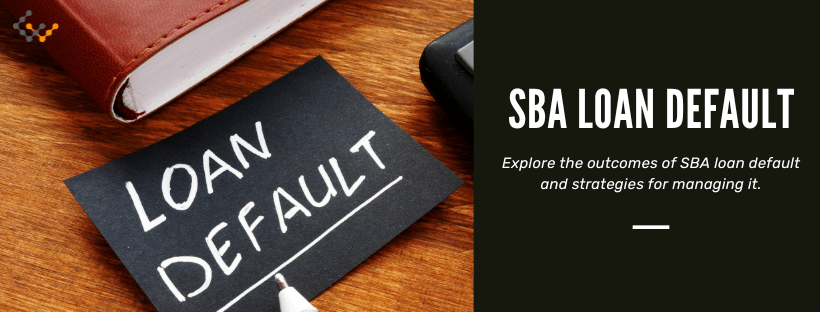SBA Loan Default: What to Do and How to Prevent It?

There are some situations where purchasing the property that your business occupies can be lucrative in the long term. Other times, changing market conditions, a lack of due diligence, or unknown factors can make the investment a bad one. For a business owner, the inability to pay back their loan is a concern, and SBA loan default is not ideal. There are some ways to prevent it, and if it is going to occur, borrowers need to know what steps to take.
What Does SBA Loan Default Mean?
In all situations, business owners with a Small Business Administration (SBA) loan will need to pay according to the terms outlined within the loan agreement. That includes payments based on the timeline established as well as the amount owed. SBA loan default occurs when the borrower does not make a payment according to those terms. It may be made late, not made at all, or made for less than what is owed.
Answer a few questions and get custom mortgage quotes. We'll match you with offers from our network of 650+ lenders.
What Happens If You Default on a SBA Loan?
When a borrower defaults on a loan, it can have numerous negative consequences. One of the most common is that it will impact the borrower’s ability to obtain another loan in the future. Additionally, the lender can seize the assets, or collateral, that holds the loan.
In this situation, it could be commercial real estate. That also means any money put into the purchase of the property, such as down payments, becomes inaccessible to the borrower.
Lenders typically do not take steps to seize real estate right away. Most often, there are demands for payment and late fees as a starting point, which ultimately will lead to the seizure of assets if the borrower fails to make payment.
The SBA loan lender will likely seize any collateral the loan was used to purchase. Then, if that is not enough, they will seek out compensation from the SBA for the insured portion of those funds owed. Once this settles the debt with the lender, it is not over for the investor.
The SBA is likely to seek out compensation from the borrower. Most often, this results in a demand letter, and if the funds are not paid within the allowed time, that is likely to lead to a seizure of any assets available. In some situations, a person may have their wages garnished and future tax returns withheld from them.
How to Identify Potential Default on an SBA Loan
Lenders will identify a loan that is not being paid quickly. When that happens, even the first missed payment, the lender will then determine that the loan is delinquent. It is common for lenders to go into action at this point to work with the borrower to determine how to get the loan payments caught up.
When there is no solution, the lender will then send a notice about the loan being in default. Typically this takes a few months, and once the lender recognizes the loan as defaulted, they will send mail and communicate in all methods possible. Typically, the company’s Registered Agent will receive notice as the process progresses, especially as legal action is taken to move the process through to seize the real estate that is being used as collateral.
In nearly all cases, lenders will continue not to provide notification about the default and will work to ensure all investors are aware of the incident.
SBA Loan Default vs Delinquent
There are two common terms used to describe late or missing payments on an SBA loan. Default is not the same as delinquent SBA loans. Delinquency refers to the initial stage of being late. That is, when a borrower misses a payment – even just one payment – the account is delinquent.
This can begin to impact lending practices, borrower qualifications for additional loans, and fines.
Default occurs after several missed payments. Delinquency leads to default if it continues, but a borrower may be able to catch up on missed payments if they are delinquent. That is harder to do when default occurs.
Default creates a much more significant impact on the borrower’s credit. Typically, at this point, the lender will require full payment owed rather than accept just late payments and fees.
How Long Before SBA Loans Go Into Default?
Continued delinquency leads to default. A lack of communication continued nonpayment, and missed fees will lead to default. This typically happens after three or four months of payments are not made.
The lender will then contact the SBA commercial real estate loan borrower to demand payment in full. Failing to do so, typically within 30 to 60 days, leads to foreclosure activities.
How to Deal with SBA Loan Default
A borrower in default from a loan should communicate with the lender about what is occurring and determine if the lender will provide any type of financial support or flexibility to get the loan caught up. It is not the lender’s obligation to rework loan terms or to make exceptions to payments. However, many will work with borrowers whenever possible.
When the lender cannot do so or when the borrower does not work with the lender, the SBA will get involved. That occurs after the lender pursues the SBA for insurance to cover what it has considered a written-off debt. Any time before this, the borrower may be able to take action to resolve the debt.
One option may be an offer in compromise. In this situation, the borrower offers a lump sum payment for less than what is owed in the hopes of that amount being enough to allow for the loan to be considered payment in full. In some cases, lenders may also accept a payment plan.
This is a legal process that can be limitedly successful, depending on the situation. In some cases, it is necessary for the borrower to work with an attorney to help them to seek out an agreement.
The Treasury Department may be willing to work out a deal with the borrower if the lender does not do so. Ultimately, the real estate may be seized to repay the borrowed funds, and additional legal action may be taken against the business owner and other stakeholders, depending on the circumstances.
Prevent SBA Loan Default: What to Do?
Preventing loan default means making payments on time. At the core of this is completing due diligence to ensure that the investment is worthwhile and then working to minimize risk by spreading out debt repayment in affordable arrangements.
When the borrower begins to struggle with making payments for any reason, they may wish to turn to their lender at that time to request support and opportunities to reorganize the loan to make it more acceptable.
Wrapping Up
Much like in a personal loan, nonpayment leads to legal action from the lender. This initially comes from the lender but will ultimately lead to the SBA taking action to recoup the invested funds in any way possible if a default occurs. Working with lenders through offers in compromise and other repayment plans may help to give borrowers more of the flexibility they need to get caught up, but if this fails, the commercial real estate being used to secure the loan may be seized.

